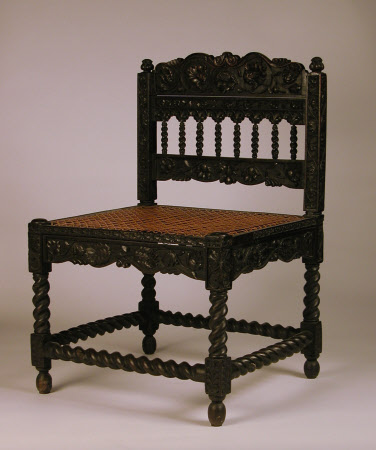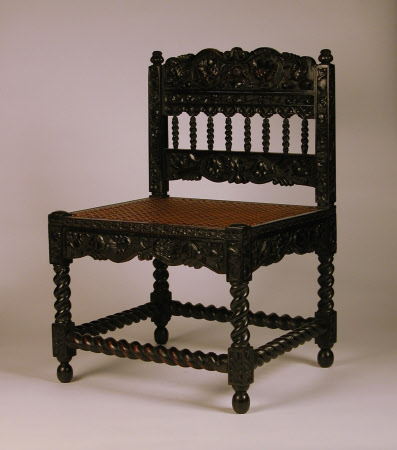A pair of ebony and cane work chairs, Coromandel Coast, India, circa 1660-1680
Category
Furniture
Date
circa 1660 - 1680
Materials
Ebony, cane
Place of origin
Coromandel Coast
Order this imageCollection
Scotney Castle, Kent
NT 790927
Summary
A pair of ebony and cane work chairs, Coromandel Coast, India, circa 1660-1680. Each with a foliate, tendril and rosette carved frame with arcaded spindle gallery to the back, flanked by uprights with finials, the cane seat raised on spiral-twist legs joined by spiral stretchers and standing on turned feet, each bearing a partial hand-written label which states that the chairs are believed to be part of a long set that formerly belonged to Cardinal Wolsey.
Full description
Amin Jaffer's study 'Furniture from British India and Ceylon' (V&A 2001) notes that this form of chair originally came from the Coromandel Coast, a textile producing region of India settled with European trading factories. There are many ebony chairs in British collections and comparable examples can be seen across the National Trust collections at Penrhyn Castle, Kingston Lacy, Cotehele, Charlecote Park and Powis Castle. Examples in the V&A collection also have similar provenance, notably a cane seat example (Museum No. IS.6-2000) with similar turnings and carved detail. This type of seventeenth century ebony furniture was very fashionable in the early years of the nineteenth century, especially sets of carved ebony chairs. In the 1750s Horace Walpole (1717-1797) acquired many pieces of such carved furniture for his Gothic house Strawberry Hill. He believed they were surviving examples of early English furniture based on their existence in houses with Tudor associations, notably Esher Palace, Surrey, where he believed them to have been the property of Cardinal Wolsey. William Beckford also had several examples of carved ebony chairs at Fonthill Abbey, described in the sale catalogue as "Wolsey chairs" (1823).
Provenance
Part of the Hussey collection. The contents were bequeathed to the National Trust in 2006 by Mrs. Elizabeth Hussey. The 1903 Scotney inventory records 'Pair carved Ebony Chairs part of a set owned by Cardinal Wolsey, one in Kensington Museum, and bought by George IV'.The book of private memoranda begun by Edward Hussey III and continued by Edward Windsor Hussey includes the note: 'Remains of inscription on paper, in my Father's writing, on back of one of the ebony chairs in the Hall: 'Ebony chairs part of a / ...hirty six, which belonged / ... C. Wolsey, of which / ...it by George ...third / ...indsor Castle.' I had always heard that the chairs formed part of a set which had belonged to Cardinal Wolsey, and last week we were shown some very similar ones, though more richly ornamented, in the private apartments at Windsor Castle by Mr Morshead the librarian there. 23 Aug 1927.'
References
Jaffer 2001 : Amin Jaffer, Furniture from British India and Ceylon, a catalogue of the collection in the Victoria and Albert Museum and the Peabody Essex Museum, London, V&A publications, 2001.

